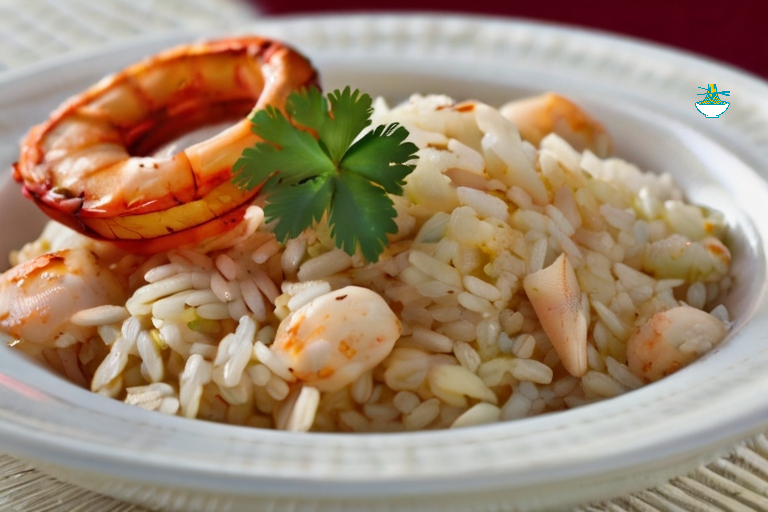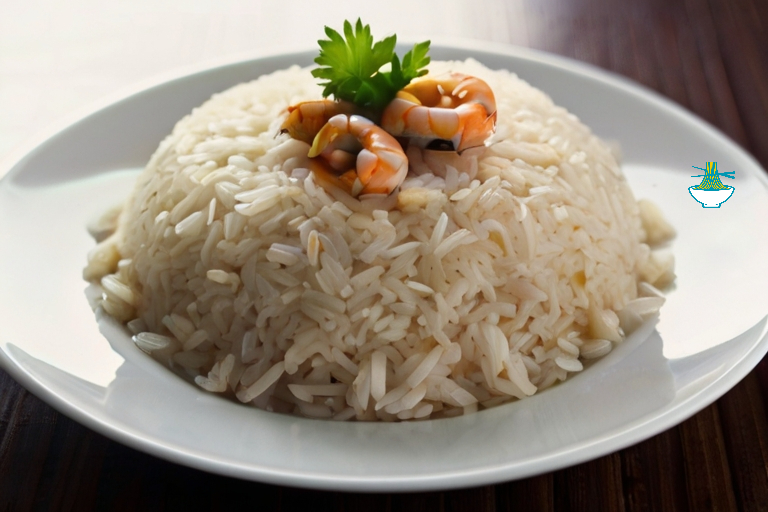Delve into the vibrant flavors of Colombian cuisine with our tantalizing dish, Arroz con Coco. This beloved traditional dish seamlessly marries the essence of coconut with the comforting wholesomeness of rice, creating a culinary masterpiece that's as rich in history as it is in taste. Picture fluffy grains of rice infused with the creamy sweetness of coconut milk, complemented by subtle hints of spices and herbs, all coming together to create a symphony of flavors that will transport your taste buds to the lush landscapes of Colombia. Whether enjoyed as a standalone delight or paired with your favorite Colombian entrees, Arroz con Coco promises a culinary adventure that celebrates the richness of Colombian culture with every delicious bite.
Ingredients:
- 2 cups long-grain white rice
- 2 cups coconut milk
- 1 ¾ cups water
- 1 tablespoon vegetable oil or butter
- 1 teaspoon salt
- ½ teaspoon ground cinnamon
- ½ teaspoon ground cloves
- ½ teaspoon ground nutmeg
- 1 bay leaf

Optional:
- Cooked seafood of your choice (shrimp, fish, crab, etc.)
Instructions:
Rinse the rice: Place the rice in a fine-mesh strainer and rinse it under cold water until the water runs clear. This helps remove excess starch for fluffier rice.
Prepare the coconut mixture: In a medium-sized saucepan, combine the coconut milk, water, vegetable oil or butter, salt, ground cinnamon, ground cloves, ground nutmeg, and bay leaf. Bring the mixture to a gentle boil over medium heat, stirring occasionally to prevent sticking.
Add the rice: Once the coconut mixture is boiling, add the rinsed rice to the saucepan. Stir well to ensure the rice is evenly distributed in the liquid.
Simmer: Reduce the heat to low, cover the saucepan with a tight-fitting lid, and let the rice simmer for about 20-25 minutes, or until the liquid is absorbed and the rice is tender. Avoid stirring the rice too much during cooking to prevent it from becoming sticky.
Optional: Add seafood: If desired, during the last 5-10 minutes of cooking, add your choice of cooked seafood to the rice mixture. Gently fold the seafood into the rice, cover, and let it finish cooking until heated through.
Fluff and serve: Once the rice is cooked and any optional seafood is heated through, remove the saucepan from the heat. Discard the bay leaf. Using a fork, fluff the rice to separate the grains.
Serve: Arroz con Coco is traditionally served hot as a side dish or as a main course accompanied by additional seafood or other Colombian delicacies. Enjoy the rich and aromatic flavors of this classic Colombian dish!
Note: Adjust seasoning according to your taste preferences. You can also customize this recipe by adding other ingredients such as raisins, green peas, or bell peppers for additional flavor and texture.
Nutritional Values:
Here's an approximate nutritional breakdown for the main ingredients in the Colombian Arroz con Coco recipe:
Long-grain white rice (2 cups, uncooked):
- Calories: 430 kcal
- Carbohydrates: 94 g
- Protein: 9 g
- Fat: 1 g
- Fiber: 2 g
benefits:
- Good source of carbohydrates, providing energy for the body.
- Contains some protein, which is essential for muscle repair and growth.
- Low in fat and cholesterol.
- Contains small amounts of fiber, aiding in digestion and promoting a feeling of fullness.
Coconut milk (2 cups):
- Calories: 960 kcal
- Carbohydrates: 16 g
- Protein: 8 g
- Fat: 100 g
- Fiber: 0 g
benefits:
- Rich in healthy fats, particularly medium-chain triglycerides (MCTs), which may support heart health and boost metabolism.
- Provides essential vitamins and minerals, such as iron, magnesium, and potassium.
- Contains lauric acid, which has antimicrobial properties and may boost immune function.
- Lactose-free, making it suitable for individuals with lactose intolerance.
Vegetable oil or butter (1 tablespoon):
- Calories: 120 kcal
- Fat: 14 g
- No significant amounts of carbohydrates, protein, or fiber
benefits:
- Source of healthy fats, which are essential for brain function and hormone production.
- Adds flavor and richness to dishes.
- May contain fat-soluble vitamins such as vitamin E (in vegetable oil) or vitamin A (in butter), which are important for skin health and immune function.
Salt (1 teaspoon):
- No significant calories, carbohydrates, protein, or fat
benefits:
- Regulates fluid balance in the body.
- Essential for nerve function and muscle contraction.
- Adds flavor to dishes.
Ground cinnamon (½ teaspoon):
- Calories: 3 kcal
- Carbohydrates: 1 g
- Fiber: 1 g
- No significant amounts of protein or fat
benefits:
- Contains antioxidants that help fight inflammation and oxidative stress.
- May help regulate blood sugar levels and improve insulin sensitivity.
- Adds a warm, aromatic flavor to dishes.
Ground cloves (½ teaspoon):
- Calories: 3 kcal
- Carbohydrates: 1 g
- Fiber: 1 g
- No significant amounts of protein or fat
benefits:
- Rich in antioxidants, which can help protect cells from damage.
- May have antimicrobial properties, helping to fight bacteria and fungi.
- Adds a distinct, spicy flavor to dishes.
Ground nutmeg (½ teaspoon):
- Calories: 6 kcal
- Carbohydrates: 1 g
- Fiber: 1 g
- No significant amounts of protein or fat
benefits:
- Contains compounds that may have anti-inflammatory and antibacterial properties.
- May aid digestion and promote gut health.
- Adds a warm, nutty flavor to dishes.
Bay leaf (1 leaf):
- No significant calories, carbohydrates, protein, or fat
benefits:
- Contains vitamins A and C, as well as minerals like calcium, magnesium, and potassium.
- May have anti-inflammatory and antimicrobial properties.
- Adds a subtle, earthy flavor to dishes.
Seafood (shrimp, fish, crab, etc. - amount varies based on choice and serving size): Nutritional values will vary based on the type and amount of seafood used.
benefits:
- Excellent source of high-quality protein, which is essential for muscle repair and growth.
- Rich in omega-3 fatty acids, which support heart health and brain function.
- Provides essential vitamins and minerals, such as vitamin D, selenium, and iodine.
- Low in saturated fat and cholesterol (depending on the type of seafood), making it a heart-healthy choice.
Please note that these values are approximate and can vary depending on factors such as brands, cooking methods, and specific ingredient choices.


Comments